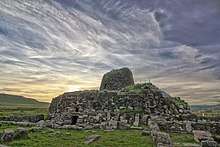Nuraghe Santu Antine
Santu Antine, also known as "Sa domo de su re" ("The house of the king" in Sardinian language) is a nuraghe (ancient megalithic edifice built by the Nuragic Civilization) in Torralba, one of the largest in Sardinia. It is located in the centre of the Cabu Abbas plain. The main structure was built around the 19-18th century BC, and the other parts of the nuraghe date back to the 17th–15th century BC. The main tower originally reached a height of 23–24 metres and contains three tholoi chambers on top of each other. The central tower with diameter of 15 metres is 17 metres high. Santu Antine is made of huge basalt blocks. It has three floors. The top floor is now gone. Some 27 meters long corridors built with the corbel arch technique can be observed inside of the Nuraghe, superimposed on two floors, the Nuraghe was provided with three wells.[1]
 | |
| Alternative name | Sa domo de su re |
|---|---|
| Location | Torralba, Sardinia, Italy |
| Type | Village |
| History | |
| Periods | Bronze Age |
| Cultures | Nuragic civilization |
Near the Nuraghe lie the remains of a Nuragic village.
The nuraghe has also been studied several times from an archaeoastronomic point of view, and these studies have shown how its structure is oriented following the solstices. These claims were supported, among others, by the archaeologist Ercole Contu and archaeostronomists Mauro Peppino Zedda, Juan Antonio Belmonte and Michael Hoskin.[2][3] In particular, Hoskin, science historian and emeritus professor at Churchill College in Cambridge, called Santu Antine "the most sophisticated dry stone monument on earth's surface".[4]
Bibliography
- Il Nuraghe Santu Antine, Ercole Contu, 1988. (PDF available at Sardegna Digital Library.)
- Belmonte Avilés, Juan Antonio; Hoskin, Michael (2002). Reflejo del cosmos : atlas de arqueoastronomía en el Mediterráneo antiguo (in Spanish). Madrid: Equipo Sirius. ISBN 84-95495-32-5. OCLC 52224308. Retrieved 2020-01-30.
See also
- Su Nuraxi di Barumini
- Nuraghe La Prisciona
- Nuragic civilization
- Talaiot
References
- https://www.researchgate.net/publication/323167563_I_Nuraghi_in_A_Moravetti_P_Melis_L_Foddai_E_Alba_eds_LA_SARDEGNA_NURAGICA_Corpora_delle_antichita_della_Sardegna_Sassari_2017_pp_29-53
- Belmonte Avilés, Juan Antonio; Hoskin, Michael (2002). Reflejo del cosmos : atlas de arqueoastronomía en el Mediterráneo antiguo (in Spanish). Madrid: Equipo Sirius. ISBN 84-95495-32-5. OCLC 52224308. Retrieved 2020-01-30.
- Littarru, Paolo (2020-01-23). "Nuraghe-triangolo, ecco il Santu Antine: 'Il monumento più sofisticato al mondo'". Sardiniapost (in Italian). Retrieved 2020-01-30.
- Belmonte Avilés, Juan Antonio; Hoskin, Michael (2002). Reflejo del cosmos : atlas de arqueoastronomía en el Mediterráneo antiguo (in Spanish). Madrid: Equipo Sirius. p. 197. ISBN 84-95495-32-5. OCLC 52224308. Retrieved 2020-01-30.
Las nuraghas más simples consisten en una cámara elevada formada por una falsa cúpula, pero muchas tienen distribuciones mucho más complejas, con murallas externas y varios niveles. Una de ellas, la de Santu Antine en Torralba, tiene una segunda cámara construida sobre la primera y una tercera sobre la segunda, lo que sin duda hace de esta nuragha el monumento de piedra seca más sofisticado sobre la superficie de la Tierra.